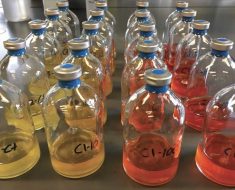
- Researchers say molecules found in mole hair may be a key to developing a new Botox-like treatment for baldness.
- They say the new treatment, if it proves successful, could be a major advancement in the field.
- Experts agree but note that the treatment has only been used in mouse models and may not be effective on human hair.
Researchers say the type of hair that could cure baldness comes from the unlikeliest of places.
Remember that oddly determined single hair growing wildly from that random mole on your body?
That’s the one.
A team of researchers says there’s a type of molecule that causes skin moles to overproduce hair. That, they say, offers a possible treatment for age-related hair loss.
All that’s required is to reshuffle the molecules a bit.
“It is a huge deal. This is an issue that impacts millions of men and women, and there are currently only treatments – no solutions,” Maksim Plikus, a lead study author and a professor of developmental and cell biology at the University of California Irvine, told Medical News Today.
“What we’ve discovered can potentially have a disruptive effect,” he added. “At present, the field is ripe for innovation, for a new compound that acts on hair follicle stem cells, re-awakening them for new hair growth.”
Details from the baldness study
In the study, published in the journal Nature, Plikus and his team report that osteopontin, a molecule that hadn’t previously been linked to hair growth, is unusually active in hairy mole skin in mouse models.
The team also found that, like in a previous mouse model, samples of human hairy skin moles increased levels of osteopontin when compared to adjacent normal skin.
The researchers’ theory states osteopontin could be injected into a balding person’s scalp to reactivate dormant hair follicles in a Botox-like procedure.
“Researchers drew inspiration from mother nature’s own experiment – millions of people have small and large moles that grow long hair,” Plikus said. “Molecules that are increased in such human skin moles might hold an answer for hair stem cell stimulation.”
“Osteopontin is particularly enriched in hairy skin moles and then micro-injected into skin it potently triggers hair stem cells and activates new hair growth. Thus, we identified new hair growth inducing protein,” he added.
Understanding the hair molecule osteopontin
Dr. Michele Green, a cosmetic dermatologist in New York who was not involved in the study, told Medical News Today that osteopontin is a signaling molecule produced by senescent pigment cells called melanocytes, which is an unlikely source of cell regeneration.
“Although senescent cells are often associated with aging, tissue death, cancer, Alzheimer’s, and cardiovascular disease, they can also regulate or trigger tissue growth and contribute to wound healing,” Green said.
“As a result of specific signals, immature stem cells can either remain dormant or become active to regenerate into specific cells or tissue,” she added. “These specific signals that trigger stem cells can be manipulated to tell the stem cells to do specific things. In this case, researchers looked into altering these signals to push the stem cells in hair follicles into a hyperactive state, causing excess hair growth.”
The potential impact of new hair growth treatment
Dr. Ryan Welter, the chief executive officer of Regeneris Medical and the founder of New England Hair Restoration, told Medical News Today that using senescent cells for hair regrowth “is particularly interesting given the senescent cells are generally considered detrimental as a part of the natural aging of organisms.”
“It seems that the unique secretome of aged melanocytes stimulate the hair follicle stem cell niche, thus stimulating hair growth into anagen. Melanocytes from mole hair will be of interest after this study,” said Welter, who was not involved in the study.
He cautioned that years of advancement in mouse studies hasn’t always translated to humans. “so we are still likely a long way off from any cure unfortunately.”
Some potential limitations
Pilkus added the new hair wouldn’t grow as wildly as mole hair because the features of the original hair follicles being stimulated remain intact.
“Hair loss is underlined by a decrease in essential signaling proteins inside of hair follicles that normally stimulate hair stem cells,” Plikus said. “Consequently, for common forms of hair loss, hair stem cells remain dormant for very long stretches of time, despite being intact. All of this makes it a challenging problem to solve.”
It’s generally accepted that, to date, there are only two popular hair loss brand names that actually work to differing degrees: Rogaine and Propecia. Neither works perfectly and aren’t right for everyone.
Pilkus is the co-founder and chief scientific officer of Amplifica, a California-based biotech company that will start human trials on the potential new hair treatment in the coming weeks.
“A compound that can achieve such an effect and that does not need to be given very often can transform the market that is currently dominated by costly and invasive hair transplantation surgery and daily medicines,” Pilkus said.
Source: Read Full Article





